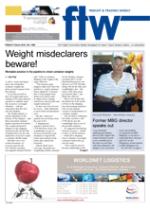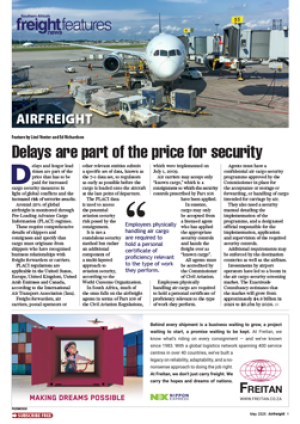A call to ‘name and shame’
those who misdeclare
container weights has
drawn mixed response from
the industry.
It’s an idea mooted in
the UK freight trade press
calling for box lines and port
operators to publicly name
the excessive overweight
offenders – with the
expectation that this will
cure the problem.
The freight industry is
utterly dependent on the
honesty of the shippers – and
their associated container
packers/operators/forwarders.
The weights declared by
shippers on the shipping
instruction (SI) and the bill
of lading (BoL) are the only
indications of just how much
a container should weigh.
But that’s not a very
certain document. As
a recent report by the
UK’s Marine Accident
Investigation Branch (MAIB)
said: “Only in container
shipping is the weight of the
cargo unknown.
“This because many
shippers either don’t have the
facilities to weigh containers
before shipment, or because
they’re discouraged from
doing so by factors such
as import taxes, loading
restrictions, and rail and road
weight restrictions.”
So they leave lots of room
for errors – either deliberate,
or more likely miscalculation
error.
But this “unknown”
quantity has not always been
the case in SA.
A shipping line
executive pointed out to
FTW that there used to be
weighbridges at each of
the ports around the coast,
intended to weigh all the
trucks and container loads
before they entered the
terminals.
Indeed, about seven
years ago, the grand new
weighbridge facility intended
for the Durban container
terminal (DCT) on the
Bayhead Road access was
big news in FTW. But that,
along with all the other port
weighbridges, has – like
many of the other great
government ideas – just
faded into oblivion.
But it’s not an idea that
has faded out of the minds
of those in the shipping
line and trucking industries
who are the ultimate
victims of misdeclaration of
container weights.
Alex de Bruyn, Safmarine
SA trades executive, told
FTW that he saw the
weighbridge idea as one of
the possible solutions.
He suggested introducing
measures in ports – similar
to those in North America
– which allow shipping
lines to identify overweight
containers before they go
into the stack.
“This could be done by
having weighbridges at the port terminals,” he added,
“and doing ‘spot checking’ of
containers as they arrive at
the port.”
He also saw it as a means
of providing adequate
deterrents. “It would allow
us to apply surcharges or
penalties relevant to the
weight variance, and/or
to refuse to transport the
overloaded container until
corrective action was taken.
“And this physical
check would make those
who are – intentionally or
unintentionally – overloading
containers more aware of the
dangers and consequences of
their actions.”
Kevin Martin, MD of
container trucking concern
Freightliner and vicechairman
of the Durban
harbour carriers’ section
of the SA Association of
Freight Forwarders (Saaff),
was another who supported
the need for weighbridges if
misdeclaration of container
weights was to be beaten.
“The shipping lines have
in the past threatened to
raise extra fees when cases
have been discovered,” he
told FTW. “Unfortunately,
this is at present rather a
toothless threat as suspecting
is one thing – but only an
assize weighbridge ‘ticket’ is
definitive proof.”
However, Martin sees
a way to use the modern
equipment now being used in
the SA container terminals
to help turn suspicion into
proof.
The present modern
stacking machines at the
terminals do have “weighing
heads” that give an indication
of mass – although it’s not a
legal proof.
The way that this would
work is that, on entry into
the terminal of the container,
the declared mass by the
loading point is entered in
the terminal system.
“When the stacking
machine lifts the container
off of the road/rail vehicle,
a comparison should be
made between this ‘declared
mass’ and that ‘weighing
head mass – with a margin
of error for both under- and
over-mass.
“And, if this is found to
be outside of the parameters,
the container is staged for
later movement to an assize
weighbridge – situated inside
the terminal, run by SA
Revenue Service (Sars).”
Then – once the correct
legal mass has been
ascertained, a charge would
be raised by Transnet on the
shipping line. The line, in
turn, would bill the client –
the guilty party – along with
any subsequent costs that
might have arisen.
“This,” said Martin,
“would then satisfy
both Transnet’s need for
compensation for assuming
this responsibility, and the
shipping line’s need for
reimbursement.”
And the port authorities
are anything but rejecting
the idea.
TPT is currently working
on a plan to be able to
introduce this vital crosscheck
of actual container
mass against declared mass.
Spokesperson Lunga
Ngcobo said that the
port’s electronics fundis
were currently very busy
tweaking all the appropriate
connections to switch the
port’s previous Cosmos
computer system over to the
new state-of-the-art Navis
system.
Also, she added, this
cross-check of declared
container mass and actual
container mass is still very
much part of the engineers’
work on the new system.
And Transnet is not doing
it for the good of its soul.
The spin-off is for Sars, in
that it will assist them in
their targeting and help to
prevent customs fraud –
especially where shippers
deliberately under-declare
the mass of containers so that
they are eligible for rebates.
Weight misdeclarers beware!
05 Mar 2010 - by Alan Peat
0 Comments
FTW - 5 Mar 10

05 Mar 2010
05 Mar 2010
05 Mar 2010
05 Mar 2010
05 Mar 2010
05 Mar 2010
05 Mar 2010
05 Mar 2010
05 Mar 2010
05 Mar 2010
05 Mar 2010
Border Beat
Featured Jobs
New
